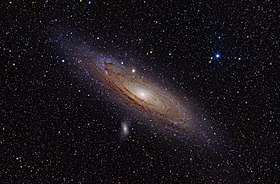Andromeda Galaxy
| Andromeda Galaxy | |
|---|---|

The Andromeda Galaxy
|
|
| Observation data (J2000 epoch) | |
| Pronunciation | /ænˈdrɒmᵻdə/ |
| Constellation | Andromeda |
| Right ascension | 00h 42m 44.3s |
| Declination | +41° 16′ 9″ |
| Redshift | z = −0.001001 (minus sign indicates blueshift) |
| Helio radial velocity | −301 ± 1 km/s |
| Distance | 2.54 ± 0.11 Mly (778 ± 33 kpc) |
| Apparent magnitude (V) | 3.44 |
| Absolute magnitude (V) | −21.5 |
| Characteristics | |
| Type | SA(s)b |
| Mass | ~1.5×1012M☉ |
| Number of stars | ~1 trillion (1012) |
| Size | ~220 kly (diameter) |
| Apparent size (V) | 3.167° × 1° |
| Other designations | |
| M31, NGC 224, UGC 454, PGC 2557, 2C 56 (Core), CGCG 535-17, MCG +07-02-016, IRAS 00400+4059, 2MASX J00424433+4116074, GC 116, h 50, Bode 3, Flamsteed 58, Hevelius 32, Ha 3.3, IRC +40013 | |
The Andromeda Galaxy (/ænˈdrɒmᵻdə/), also known as Messier 31, M31, or NGC 224, is a spiral galaxy approximately 780 kiloparsecs (2.5 million light-years) from Earth. It is the nearest major galaxy to the Milky Way and was often referred to as the Great Andromeda Nebula in older texts. It received its name from the area of the sky in which it appears, the constellation of Andromeda, which was named after the mythological princess Andromeda.
Andromeda is approximately 220,000 light years across, and it is the largest galaxy of the Local Group, which also contains the Milky Way, the Triangulum Galaxy, and other smaller galaxies. Despite earlier findings that suggested that the Milky Way contains more dark matter and could be the largest in the grouping, the 2006 observations by the Spitzer Space Telescope revealed that Andromeda contains one trillion (1012) stars: at least twice the number of stars in the Milky Way, which is estimated to be 200–400 billion. The mass of the Andromeda Galaxy is estimated to be 1.5×1012solar masses, while the Milky Way is estimated to be 8.5×1011 solar masses.
...
Wikipedia
